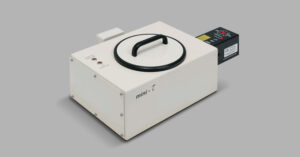Fluorescence lifetime standards are useful for checking the calibration of fluorescence lifetime spectrometers and accounting for the possible wavelength dependent response of detectors. An effective fluorescence lifetime standard should have a monoexponential fluorescence decay that is independent of the choice of excitation and emission wavelength.
The recommended reference for fluorescence lifetime standards is Anal. Chem. 79 2137-2149 (2007) which was a multinational collaboration involving nine research institutions. The fluorescence lifetimes of 20 fluorophore and solvent combinations were independently measured by each research institution using time and frequency domain lifetime spectrometers to give a set of 20 accurately known fluorescence lifetimes. The mean lifetimes reported by the study and the excitation and emission wavelengths used are given in the table below.
| Compound [a] | Solvent | τ (ns) [b] | λex (nm) | λem (nm ) |
|---|---|---|---|---|
| 9-cyanoanthracene | methanol cyclohexane | 16 ±1 12.7 ± 0.7 | 295-360 295-360 | 400-480 400-450 |
| anthracene | methanol cyclohexane | 5.1 ± 0.3 5.3 ± 0.1 | 295-360 295-360 | 375-442 375-442 |
| coumarin 153 | methanol | 4.3 ± 0.2 | 295-442 | 495-550 |
| DPA | methanol cyclohexane | 8.7 ± 0.5 7.5 ± 0.4 | 295-360 295-360 | 400-475 400-475 |
| erythrosin B | water methanol | 0.089 ± 0.003 0.47 ± 0.02 | 488-568 488-568 | 550-580 550-590 |
| NATA | water | 3.1 ± 0.1 | 295-309 | 330-410 |
| N-methylcarbazole | cyclohexane | 14.1 ± 0.9 | 290-325 | 350-400 |
| POPOP | cyclohexane | 1.12 ± 0.04 | 295-360 | 380-450 |
| PPO | methanol cyclohexane | 1.65 ± 0.05 1.36 ± 0.04 | 295-330 290-325 | 340-400 360-450 |
| p-terphenyl | methanol cyclohexane | 1.17 ± 0.08 0.98 ± 0.03 | 284-315 290-315 | 330-380 330-390 |
| rhodamine B | water methanol | 1.74 ± 0.02 2.5 ± 0.1 | 488-575 295,488-568 | 560-630 550-630 |
| rubrene | methanol | 9.9 ± 0.3 | 300, 488, 514 | 550-610 |
| SPA | water | 31.2 ± 0.4 | 300-330 | 466-520 |
Mean lifetimes of fluorescence standards and their excitation and emission ranges. Data obtained from Anal. Chem. 79 2137-2149 (2007).1 The samples were measured at 20 °C and the solutions degassed using freeze pump thaw or inert gas bubbling.
[a] Compound Names
DPA: 9,10-diphenylanthracene
NATA: N-acetyl-L-tryptophanamide
POPOP:1,4-bis(5-phenyloxazol-2-yl)benzene
PPO: 2,5-diphenyloxazole
SPA: N-(3-sulfopropyl)acridinium
[b] The quoted lifetime is the mean value across the different measuring institutions and the error is the sample standard deviation. The solutions were degassed prior to measurement and since oxygen is a fluorescence quencher measurement of non-degassed solutions will result in shorter lifetimes than reported here.

